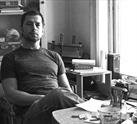DAVID WILSON
Wilson’s previous practice has included works of urban high realism and the exploring of the human figure. His most recent works depict loosely rendered images of urban settings either at night or during the transitional period of day one finds between darkness and light. “For several years my work has examined how at night, the selective illumination of the city lays bare our value systems. In developing this body of work it became apparent to me that both the people and objects not deemed "important" drift into the darkness. Our efforts to illuminate what we discern as valuable often results in the marginalization of those dwelling within the shadows thereby creating a juxtaposition between darkness and light. At this point, what is invisible becomes as important as the visible. Now as I paint I imagine how the face of the city will appear in ten years, twenty years and beyond. Our appetite for and reliance upon cheap energy increases while easy access diminishes. Galaxies of city lights that slip off into the horizon while we sleep may become a thing of the past. The modern city of today appears destined to shift towards something we are presently unable to imagine and are not likely prepared for.”
ARTIST STATEMENT
For several years my work has examined how at night, the selective illumination of the city lays bare our value systems. In developing this body of work it became apparent to me that both the people and objects not deemed "important" drift into the darkness. Our efforts to illuminate what we discern as valuable often results in the marginalization of those already dwelling within the shadows, forcing an even further shift towards obscurity. In creating a juxtaposition of darkness and light, this dichotomy is negated and the invisible becomes as important as the visible.
The city surrounds us with largely unnoticed and seemingly inadvertent abstract compositions. People, structures and reworked geographies scribe their individual marks on the urban landscape. When those marks collaborate and are observed from a distance, definite designs begin to appear. Images form, presenting something recognizable, familiar even, irrespective of what city is being observed. The nightscape breeds familiarity, removing many of the commonly recognized specifics unique to a city; specifics that are easily recognizable in daylight but more difficult to determine at night. The result is an urban environment defined by the globally common experience of artificial lighting.
Within this nightscape there are intersecting moments of movements; people shuttling about via mass transportation, in automobiles or simply on foot. This motion, or impending motion, is one of the many elements factoring into a composition. Taxis and buses often appear in my work as a metaphor for the isolation and communion one finds within the city. The daily commute unites a variety of class distinctions, cultures, and demographics, the resulting experience ranging from voluntary isolation to forced interaction. Vehicles come to exist as symbols for these inhabitants of the city.
There is a sense that "anything can happen" in the nocturnal urban landscape. One never knows what lies around the corner. What is suggested by the shadows has the potential for an immediate impact on what happens in the light. Paintings of the night remove many of the definitions defined by day, transforming the known into something less recognizable. Parameters of understanding shift. What was once familiar becomes difficult to identify as we attempt to reorient ourselves to the new perspective darkness brings.
|